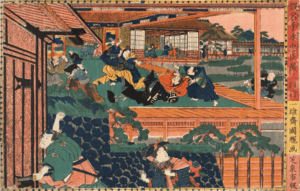Chūshingura facts for kids
Chūshingura (忠臣蔵, The Treasury of Loyal Retainers) is a famous Japanese story. It's about a group of forty-seven masterless samurai. They go on a mission to get revenge for their master, Asano Naganori. This story has been told in many ways. You can find it in plays like kabuki and bunraku, in movies, books, and TV shows. Chūshingura is one of the most well-known historical tales in Japan.
Contents
The Real Story Behind Chūshingura
The real events that inspired Chūshingura happened in 1701. The ruler of Japan, called the shōgun, was Tokugawa Tsunayoshi. He put a lord named Asano Takumi-no-kami Naganori in charge of welcoming visitors. Asano was a daimyō, a powerful feudal lord, from a place called Akō.
A special official named Kira Kōzuke-no-suke Yoshinaka was supposed to teach Asano the proper manners for the ceremony. One day, at Edo Castle, Asano suddenly attacked Kira with a short sword. We don't know why he did this. Some people think Kira might have insulted him.
Because of this attack, Asano was ordered to commit seppuku. This was a ritual suicide for samurai. But Kira did not get any punishment. Asano's lands were taken away, and his samurai lost their jobs. They became rōnin, which means masterless samurai.
Almost two years later, Ōishi Kuranosuke Yoshio led a group of forty-six or forty-seven rōnin. Ōishi had been a high-ranking samurai for Asano. They broke into Kira's house in Edo and killed him. After this, they turned themselves in to the authorities. They were all sentenced to commit seppuku on the same day.
Ōishi is the main hero in most versions of this story. The real event is called the Akō incident. The fictional stories are known as the Treasury of Loyal Retainers, or Chūshingura. The first time this story was written about in the West was in 1822.
Why the Story is Important
The story of the 47 rōnin also has a deeper meaning. It shows the idea of chūshin gishi. This means "loyal and dutiful samurai." It describes people who gave their lives for a big cause. They were often honored after they died. Sometimes, special shrines were built for them.
Bunraku Puppet Play
One of the most famous versions of the story is a puppet play called Kanadehon Chūshingura. It was written by Takeda Izumo, Miyoshi Shōraku, and Namiki Senryū. It was first performed in 1748 in Osaka. A very similar kabuki play came out later that year.
The title means "Kana practice book Treasury of the loyal retainers." The number of rōnin was the same as the number of kana characters. In the play, each rōnin showed a kana to identify himself. The title also compared the loyal rōnin to a valuable treasure.
To avoid problems with the government, the writers changed the time period of the story. They also changed the names of the main characters. This famous play is still performed every year. Often, only a few parts of the play are shown, not the whole thing.
Chūshingura in Movies and TV
December is a popular time to see Chūshingura performances. This is because the real break-in happened in December, according to the old calendar.
Movies
The first Chūshingura movie was made in 1907. The first original movie version came out in 1908. Many famous Japanese actors have played the role of Ōishi. The part of Asano's wife, Aguri, is often given to very beautiful actresses. Kira is usually played by an older actor.
In 1941, a director named Kenji Mizoguchi made a film called The 47 Ronin. The Japanese military wanted a strong, exciting movie. But Mizoguchi made a more thoughtful film. It was not very popular at first in Japan.
After World War II, the story was banned for a short time. This was because it was thought to promote old feudal ideas. But the ban was lifted in 1947. Since then, many more films have been made.
A Hollywood movie called 47 Ronin came out in 2013. It starred Keanu Reeves. This movie was a fantasy story. It added magic and new characters. Many people felt it was very different from the original Japanese story.
Television Dramas
The story of Chūshingura has also been made into many TV shows. The 1964 NHK show Akō Rōshi was followed by more than 20 other TV versions. Many famous actors have played Ōishi and Kira in these shows. In 2001, Fuji TV made a four-hour special called Chūshingura 1/47. In 2007, a ten-hour special called Chūshingura Yōzeiin no Inbō was released.
Many Japanese writers have also written novels about the Chūshingura story.
Other Ways the Story is Told
- Ballet: A ballet called "The Kabuki" was created in 1986. It is based on the Chūshingura legend. It has been performed many times around the world.
- Opera: The story was turned into an opera in 1997.
- Music: A band called Jefferson Airplane has an instrumental song named "Chushingura."
- Books: The story has appeared in many books. This includes a short story by Jorge Luis Borges. It has also been made into comic books and graphic novels.
- Anime: An episode of the show Lupin III Part 2 has a funny version of the Chūshingura story.
See also
- Chūshingura: Hana no Maki, Yuki no Maki
- Matsu no Ōrōka


